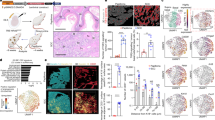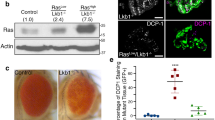Abstract
Proteins of the Rho family control signalling pathways that regulate the actin cytoskeleton and gene transcription1,2. In vitro studies have implicated Rho-like GTP-hydrolysing enzymes (GTPases) in cell migration3,4,5, cell-cycle progression6,7, and Ras-induced focus formation8,9, suggesting a role for these GTPases in the formation and progression of tumours in vivo. To study this, we have generated mice lacking the Rac-specific activator Tiam110,11,12, a T-lymphoma invasion and metastasis inducing protein. Here we show that such Tiam1-/- mice are resistant to the development of Ras-induced skin tumours initiated with 7,12-dimethylbenzanthracene and promoted with 12-O-tetradecanoylphorbol-13-acetate. Moreover, the few tumours produced in Tiam1-/- mice grew much slower than did tumours in wild-type mice. Tiam1-deficient primary embryonic fibroblasts were also resistant to RasV12-induced focus formation. Analysis of Tiam1 heterozygotes indicated that both tumour initiation and promotion were dependent on the Tiam1 gene dose. Tiam1 deficiency was associated with increased apoptosis during initiation, and with impeded proliferation during promotion. Although the number of tumours in Tiam1-/- mice was small, a greater proportion progressed to malignancy, suggesting that Tiam1 deficiency promotes malignant conversion. Our studies identify the Rac activator Tiam1 as a critical regulator of different aspects of Ras-induced tumour formation.
This is a preview of subscription content, access via your institution
Access options
Subscribe to this journal
Receive 51 print issues and online access
$199.00 per year
only $3.90 per issue
Buy this article
- Purchase on Springer Link
- Instant access to full article PDF
Prices may be subject to local taxes which are calculated during checkout




Similar content being viewed by others
References
Hall, A. Rho GTPases and the actin cytoskeleton. Science 279, 509–514 (1998)
Bar-Sagi, D. & Hall, A. Ras and Rho GTPases: a family reunion. Cell 103, 227–238 (2000)
Hordijk, P. L. et al. Inhibition of invasion of epithelial cells by Tiam1-Rac signalling. Science 278, 1464–1466 (1997)
Keely, P. J., Westwick, J. K., Whitehead, I. P., Der, C. J. & Parise, L. V. Cdc42 and Rac1 induce integrin-mediated cell motility and invasiveness through PI(3)K. Nature 390, 632–636 (1997)
Shaw, L. M., Rabinovitz, I., Wang, H. H. F., Toker, A. & Mercurio, A. M. Activation of phosphoinositide 3-OH kinase by the α6β4 integrin promotes carcinoma invasion. Cell 91, 949–960 (1997)
Olson, M. F., Ashworth, A. & Hall, A. An essential role for Rho, Rac, and Cdc42 GTPases in cell cycle progression through G1. Science 269, 1270–1272 (1995)
Olson, M. F., Paterson, H. F. & Marshall, C. J. Signals from Ras and Rho GTPases interact to regulate expression of p21Waf1/Cip1. Nature 394, 295–299 (1998)
Qiu, R. G., Chen, J., Kirn, D., McCormick, F. & Symons, M. An essential role for Rac in Ras transformation. Nature 374, 457–459 (1995)
Khosravi-Far, R., Solski, P. A., Clark, G. J., Kinch, M. S. & Der, C. J. Activation of Rac and Rho, and mitogen activated protein kinases, are required for Ras transformation. Mol. Cell. Biol. 15, 6443–6453 (1995)
Habets, G. G. M. et al. Identification of an invasion-inducing gene, Tiam1, that encodes a protein with homology to GDP-GTP exchangers for Rho-like proteins. Cell 77, 537–549 (1994)
Michiels, F., Habets, G., Stam, J., van der Kammen, R. & Collard, J. A role for Rac in Tiam1-induced membrane ruffling and invasion. Nature 375, 338–340 (1995)
Worthylake, D., Rossman, K. & Sondek, J. Crystal structure of Rac1 in complex with the guanine nucleotide exchange region of Tiam1. Nature 408, 682–688 (2000)
Ehler, E., van Leeuwen, F., Collard, J. & Salinas, P. Expression of Tiam-1 in the developing brain suggests a role for the Tiam-1-Rac signalling pathway in cell migration and neurite outgrowth. Mol. Cell Neurosci. 9, 1–12 (1997)
Yuspa, S. H. The pathogenesis of squamous cell cancer: lessons learned from studies of skin carcinogenesis. J. Dermatol. Sci. 17, 1–7 (1998)
Frame, S. & Balmain, A. Integration of positive and negative growth signals during ras pathway activation in vivo. Curr. Opin. Genet. Dev. 10, 106–113 (2000)
Quintanilla, M., Brown, K., Ramsden, M. & Balmain, A. Carcinogen-specific mutation and amplification of Ha-ras during mouse skin carcinogenesis. Nature 322, 78–80 (1986)
Zoumpourlis, V. et al. High levels of phosphorylated c-Jun, Fra-1, Fra-2 and ATF-2 proteins correlate with malignant phenotypes in the multistage mouse skin carcinogenesis model. Oncogene 19, 4011–4021 (2000)
Buchmann, A., Ruggeri, B., Klein-Szanto, A. J. P. & Balmain, A. Progression of squamous carcinoma cells to spindle carcinomas of mouse skin is associated with an imbalance of H-Ras alleles on chromosome 7. Cancer Res. 51, 4097–4101 (1991)
Zondag, G. C. M. et al. Oncogenic Ras downregulates Rac activity, which leads to increased Rho activity and epithelial-mesenchymal transition. J. Cell Biol. 149, 775–781 (2000)
Kemp, C. J., Donehower, L. A., Bradley, A. & Balmain, A. Reduction of p53 gene dosage does not increase initiation or promotion but enhances malignant progression of chemically induced skin tumors. Cell 74, 813–822 (1993)
Joneson, T. & Bar-Sagi, D. Suppression of Ras-induced apoptosis by the Rac GTPase. Mol. Cell Biol. 19, 5892–5901 (1999)
Robles, A. I. et al. Reduced skin tumour development in cyclin D1-deficient mice highlights the oncogenic ras pathway in vivo. Genes Dev. 12, 2469–2474 (1998)
Sander, E. E. et al. Matrix-dependent Tiam1/Rac signalling in epithelial cells promotes either cell-cell adhesion or cell migration and is regulated by phosphatidylinositol 3-kinase. J. Cell Biol. 143, 1385–1398 (1998)
Sander, E. E., ten Klooster, J. P., van Delft, S., Van der Kammen, R. A. & Collard, J. G. Rac downregulates Rho activity: reciprocal balance between both GTPases determines cellular morphology and migratory behaviour. J. Cell Biol. 147, 1009–1022 (1999)
Braga, V. M. M., Machesky, L. M., Hall, A. & Hotchin, N. A. The small GTPases rho and rac are required for the establishment of cadherin-dependent cell-cell contacts. J. Cell Biol. 137, 1421–1431 (1997)
Takaishi, K., Sasaki, T., Kotani, H., Nishioka, H. & Takai, Y. Regulation of cell-cell adhesion by Rac and Rho small G proteins in MDCK cells. J. Cell Biol. 139, 1047–1059 (1997)
Bracke, M. E., Van Roy, F. M. & Mareel, M. M. The e-cadherin/catenin complex in invasion and metastasis. Curr. Top. Microbiol. Immunol. 213, 123–161 (1996)
Perl, A. K., Wilgenbus, P., Dahl, U., Semb, H. & Christofori, G. A causal role for E-cadherin in the transition from adenoma to carcinoma. Nature 392, 190–193 (1998)
de Rooij, J. & Bos, J. L. Minimal Ras-binding domain of Raf1 can be used as an activation-specific probe for Ras. Oncogene 14, 623–625 (1997)
Acknowledgements
We thank J.-Y. Song and the Animal Pathology department of the Netherlands Cancer Institute for histological analysis; D. Stuart, P. Demant and A. Hurlstone for advice; P. Krimpenfort and T. Schrauwers for experimental support; V. Zoumbourlis and A. Balmain for cell lines; and the animal facility of the Netherlands Cancer Institute for providing animal care. Part of this work was supported by the Dutch Cancer Society, the European Community, and the Association for International Cancer Research.
Author information
Authors and Affiliations
Corresponding author
Ethics declarations
Competing interests
The authors declare that they have no competing financial interests.
Supplementary information
Rights and permissions
About this article
Cite this article
Malliri, A., van der Kammen, R., Clark, K. et al. Mice deficient in the Rac activator Tiam1 are resistant to Ras-induced skin tumours. Nature 417, 867–871 (2002). https://doi.org/10.1038/nature00848
Received:
Accepted:
Issue Date:
DOI: https://doi.org/10.1038/nature00848
This article is cited by
-
Synthetic lethal kinases in Ras/p53 mutant squamous cell carcinoma
Oncogene (2022)
-
The Rho guanosine nucleotide exchange factors Vav2 and Vav3 modulate epidermal stem cell function
Oncogene (2022)
-
A RAC-GEF network critical for early intestinal tumourigenesis
Nature Communications (2021)
-
Vav2 pharmaco-mimetic mice reveal the therapeutic value and caveats of the catalytic inactivation of a Rho exchange factor
Oncogene (2020)
-
VAV2 signaling promotes regenerative proliferation in both cutaneous and head and neck squamous cell carcinoma
Nature Communications (2020)
Comments
By submitting a comment you agree to abide by our Terms and Community Guidelines. If you find something abusive or that does not comply with our terms or guidelines please flag it as inappropriate.



